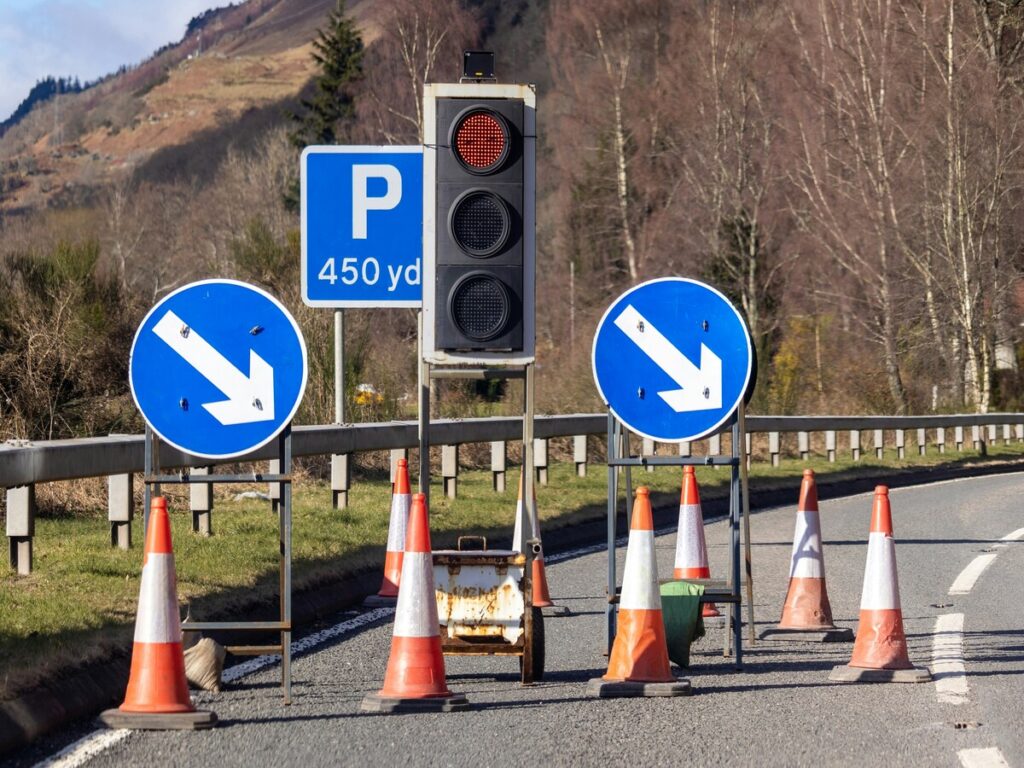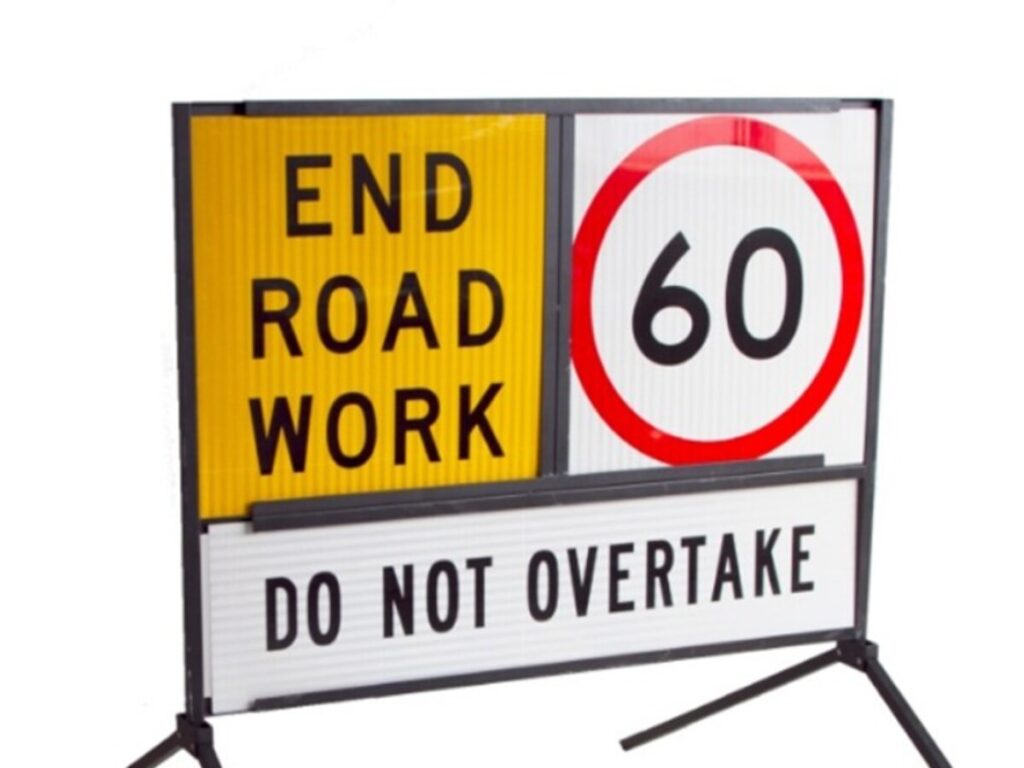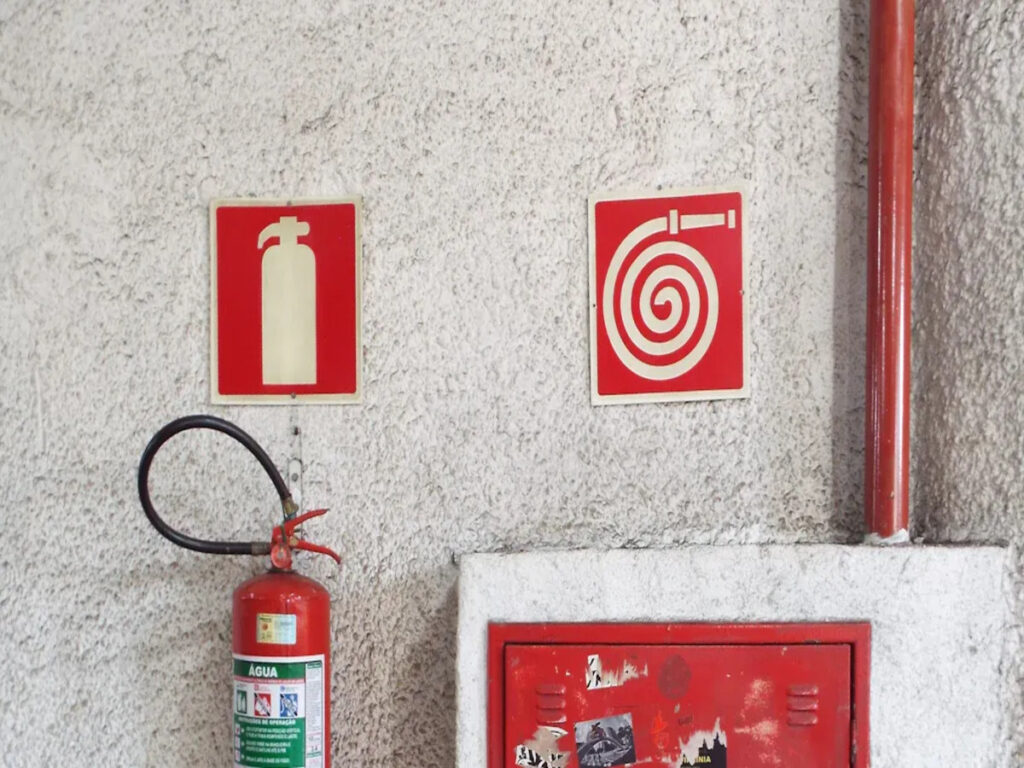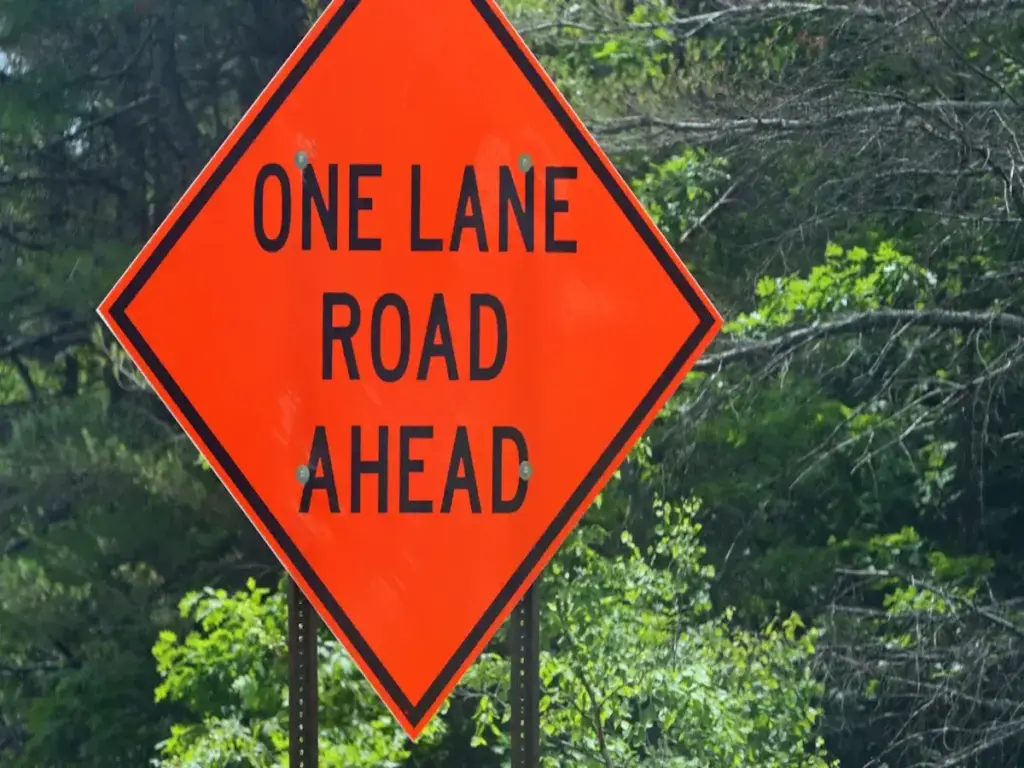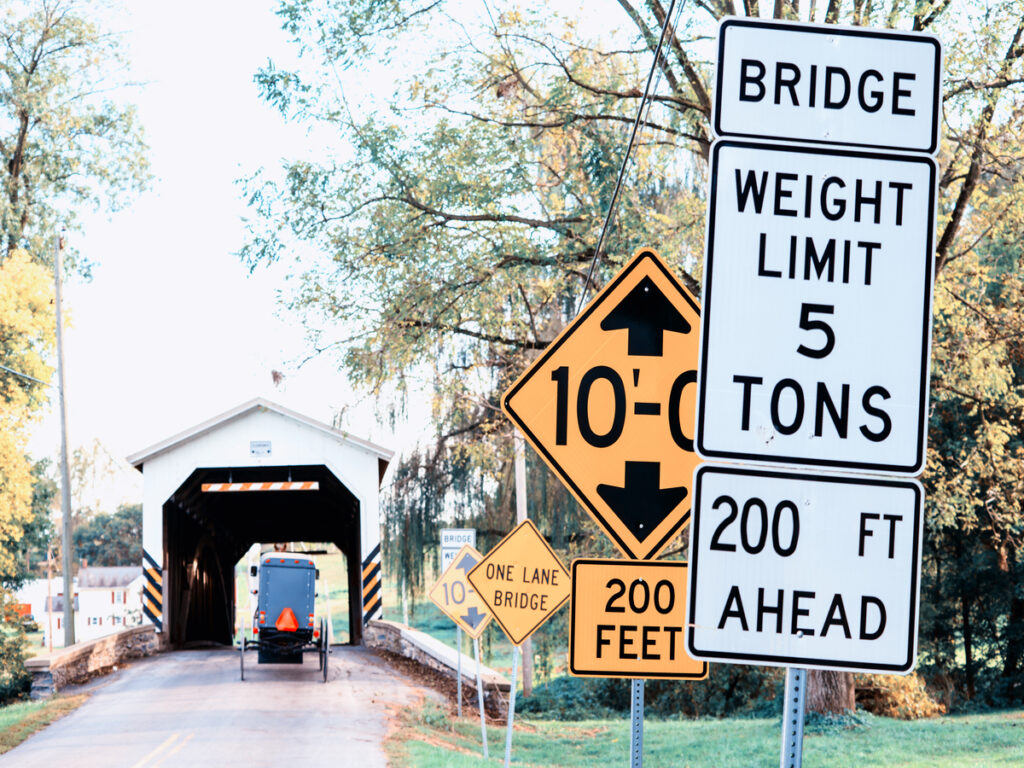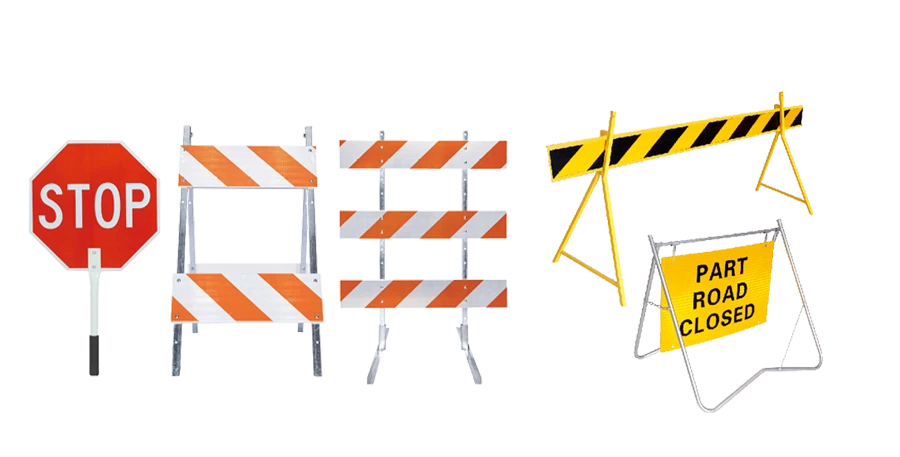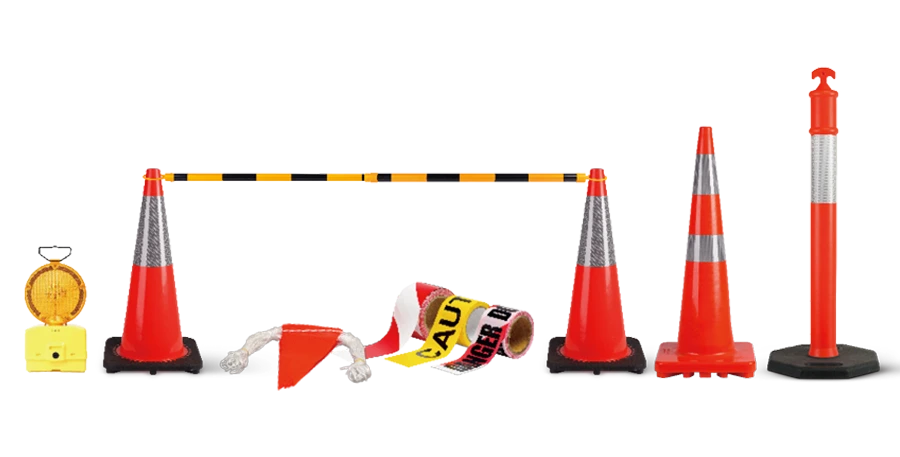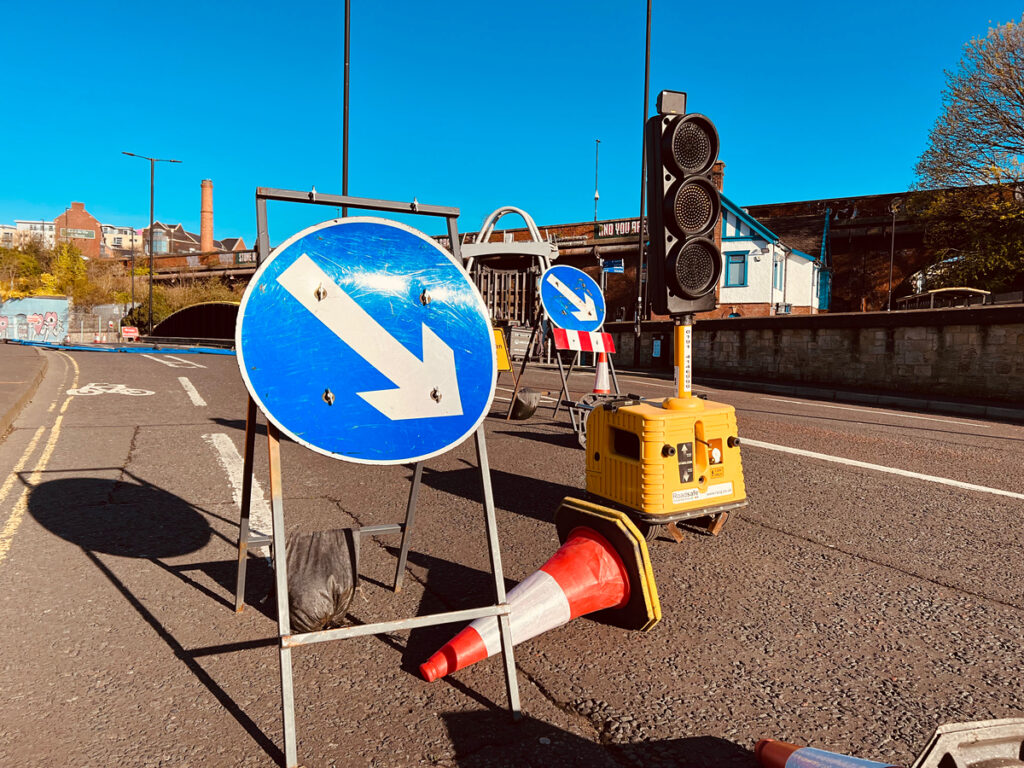
MUTCD -Regeln sind wichtig für die Verkehrssicherheit und gesetzliche Standards. Tragbare Verkehrszeichenrahmen, die diese Regeln einhalten, geringere Risiken und den Verkehr besser bewegen. Die Verwendung der richtigen Geräte kann den Unfall und Verletzungen stoppen. Zum Beispiel, in Texas, Arbeitszonen hatten 35% Weniger Stürze für Autoarbeiter. In Kalifornien, Verletzungen vergingen 25%. Zonen mit richtigen Werkzeugen hatten ebenfalls bis zu 50% weniger Unfälle. Diese Tatsachen zeigen, dass die Befolgung von MUTCD -Regeln vorübergehende Verkehrsbereiche sicherer und effizienter macht.
Während MUTCD in den USA den Standard setzt., In anderen Regionen gelten eigene Vorschriften zur vorübergehenden Verkehrskontrolle. Um zu sehen, wie die USA. im Vergleich zur EU und Australien, Schauen Sie sich unseren vollständigen Leitfaden an: USA gegen EU gegen Australien: Wie sich Straßenschildrahmen in Standards und Übung unterscheiden.
Key Takeaways
- Reflektierende Materialien machen nachts Schilder leichter zu sehen. Autofahrer können Schilder schon von weitem erkennen, was die Wahrscheinlichkeit von Abstürzen verringert.
- Verkehrsschilder müssen regelmäßig überprüft werden, um ihre Sicherheit zu gewährleisten. Schauen Sie sich ihre Größe an, Stärke, und Sichtbarkeit, um die Regeln einzuhalten und alle zu schützen.
- Informieren Sie Ihr Team über die MUTCD-Regeln, um Fehler zu vermeiden. Geschulte Fachkräfte können Schilder richtig aufstellen, Verbesserung der Sicherheits- und Verkehrsfluss.
- Der Kauf von MUTCD-zugelassenen Rahmen spart auf lange Sicht Geld. Starke Materialien halten länger und erfordern weniger Reparaturen, sie zu einer klugen Wahl machen.
MUTCD verstehen und warum es wichtig ist
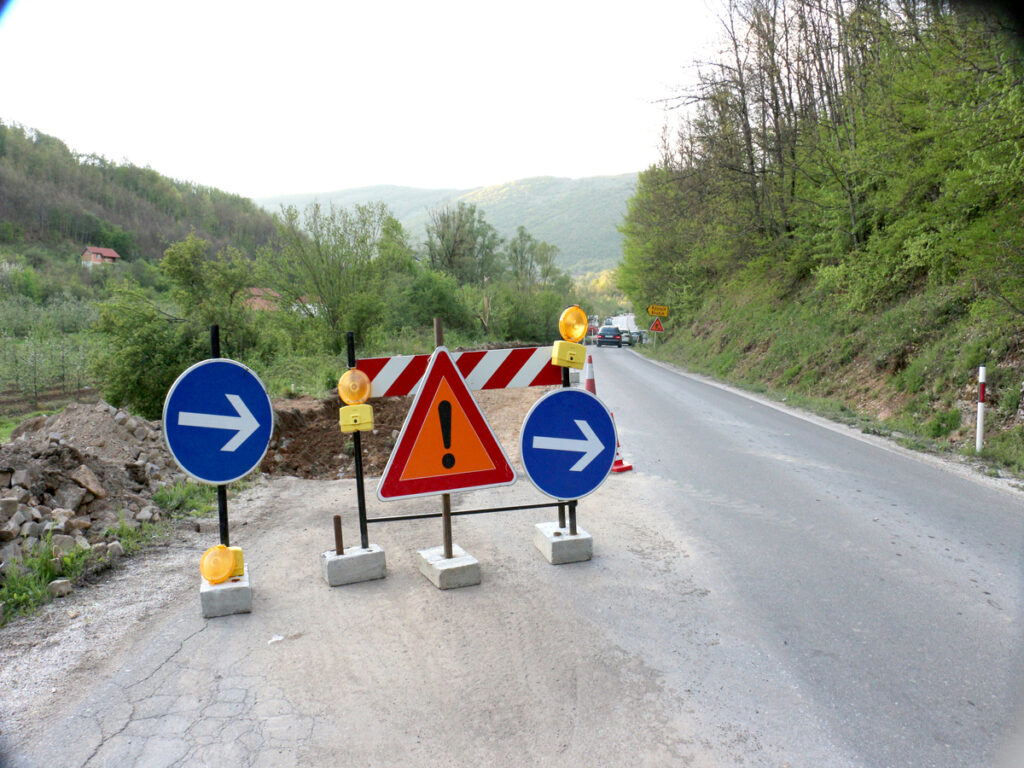
Was ist die MUTCD??
Die MUTCD ist ein Leitfaden für Verkehrszeichen, Signale, und Markierungen. Es stellt sicher, dass die Straßen überall in den USA klare und einheitliche Schilder haben. Der Bundesstraßenverwaltung (Fhwa) verwaltet die MUTCD. Im Laufe der Zeit, Es hat sich geändert, um den modernen Verkehrsanforderungen gerecht zu werden. Die erste Version erschien in 1935. Seitdem, Es gab neun Aktualisierungen zur Verbesserung der Verkehrskontrolle.
| Jahr | Ereignis/Beschreibung |
|---|---|
| 1927 | AASHO hat einen Leitfaden für Landstraßen erstellt. |
| 1930 | NCSHS hat einen Leitfaden für Stadtstraßen erstellt. |
| 1935 | Erste MUTCD, veröffentlicht von AASHO und NCSHS. |
| 1971 | FHWA übernahm die Leitung von MUTCD. |
Wenn Sie mehr über die MUTCD erfahren, wird deutlich, wie sie dazu beiträgt, die Straßen sicherer zu machen.
Warum MUTCD-Regeln für die Sicherheit wichtig sind
MUTCD-Regeln tragen dazu bei, Unfälle zu verhindern und die Verkehrssicherheit zu verbessern. Sie sorgen dafür, dass Schilder und Signale leicht zu sehen und zu lesen sind. Zum Beispiel, Die MUTCD listet Bedingungen für das Hinzufügen von Verkehrssignalen auf. Dazu gehören Fußgängerzahlen, Crash History, und geschäftige Verkehrszeiten.
- Gewährleistung 1: Achtstündiges Verkehrsaufkommen
- Gewährleistung 4: Fußgängerzahlen
- Gewährleistung 7: Absturzverlauf
Die Einhaltung dieser Regeln macht die Straßen für alle sicherer. Aktualisierungen wie bessere Zebrastreifen und Blinklichter helfen den Menschen, Schilder zu erkennen und Unfälle zu vermeiden.
MUTCD-Konformität in temporären Verkehrszonen
Temporäre Zonen, Wie Baustellen, muss den MUTCD-Regeln folgen. Diese Regeln stellen sicher, dass Schilder und Absperrungen angebracht werden, um die Sicherheit der Menschen zu gewährleisten. Tragbare Schilderrahmen müssen den Höhen- und Stabilitätsstandards entsprechen. Reflektierende Materialien erleichtern die Sichtbarkeit von Schildern bei Nacht oder schlechten Lichtverhältnissen.
| Verkehrsgerät | Zweck |
|---|---|
| Zweistufige Wendekästen | Prüfen Sie, ob Autofahrer und Biker sie sicher und richtig nutzen. |
| Rotes Pflaster in Transitspuren | Testen Sie, ob es die Sicherheit erhöht und für reine Durchgangsspuren gut funktioniert. |
Durch die Verwendung von MUTCD-Regeln wird sichergestellt, dass temporäre Zonen sicher sind und gut funktionieren.
Wichtige Regeln für MUTCD-zugelassene Verkehrszeichenrahmen
Die Verwendung der MUTCD-Regeln für tragbare Schilderrahmen gewährleistet die Sicherheit der Straßen. Diese Regeln konzentrieren sich auf die Schildhöhe, Reflexionsvermögen, und Lesbarkeit. Lassen Sie uns sie aufschlüsseln.
Regeln für die Höhe und Platzierung von Schildern
Die Schilder müssen so hoch sein, dass sie vom Autofahrer gut gesehen werden können. MUTCD gibt klare Regeln dafür, wie hoch die Vorzeichen sein sollten.
- In den meisten Bereichen, Schilder müssen mindestens sein 5 Füße hoch.
- In Fußgängerzonen, Zeichen müssen sein 7 Füße hoch, um Personen nicht zu blockieren.
- Die Schilder müssen stabil bleiben, Auch bei windigem Wetter.
Für Wegweiser, MUTCD empfiehlt die Verwendung einer speziellen Schriftart namens FHWA-Serie E (Geändert). Diese Schriftart ist aus der Ferne gut lesbar, bis zu 1,000 Füße. Die Buchstaben werden größer gemacht, um 27 Zoll groß. MUTCD sagt auch, dass Schilder lesbar sein sollten 40 Füße für jeden Zentimeter Buchhöhe. Zum Beispiel, ein Schild mit 16-Zoll-Buchstaben ist lesbar 640 Füße entfernt.
Die Platzierung der Schilder hängt davon ab, wie schnell die Autos fahren. Bei Geschwindigkeiten von 20 Zu 70 Meilen pro Stunde, Es müssen Schilder angebracht werden, damit die Fahrer Zeit zum Reagieren haben. Ältere Fahrer brauchen ca 0.66 Sekunden, um Zeichen zu bemerken und darauf zu reagieren.
Reflektierende Materialien für bessere Sichtbarkeit
Schilder müssen nachts oder bei schlechtem Wetter gut erkennbar sein. MUTCD erfordert reflektierende Materialien, um Schilder unter Scheinwerfern sichtbar zu machen.
- Reflektierende Folien müssen Mindesthelligkeitswerte aufweisen. Typ I- oder II-Folien sind üblich, aber härtere Bedingungen erfordern möglicherweise bessere Materialien.
- Auf Baustellen werden häufig leuchtend orangefarbene reflektierende Folien verwendet, um hervorzustechen.
- Reflektierende Materialien müssen über einen längeren Zeitraum wirksam bleiben. Verblasste oder beschädigte Schilder entsprechen nicht den MUTCD-Regeln.
Verwendung hochwertiger reflektierender Materialien, Wie Diamantenblatt, Macht Schilder heller. Diese Materialien helfen Autofahrern, Schilder aus größerer Entfernung zu erkennen, Dies ist auf stark befahrenen oder schwierigen Straßen von entscheidender Bedeutung.
Leicht lesbare Buchstaben und Farben
Die Beschilderung muss klar und leicht verständlich sein. MUTCD hat Regeln für die Buchstabengröße, Schriftart, und Farben.
Die FHWA schreibt vor, dass alle Verkehrszeichen Standardschriftarten verwenden müssen. Dies sorgt für einheitliche Designs und vermeidet Verwirrung.
Für Autobahnschilder, MUTCD empfiehlt Serie E (Geändert) Buchstaben. Diese Buchstaben sind bei hoher Geschwindigkeit gut lesbar. MUTCD verwendet auch bestimmte Farben für verschiedene Nachrichten:
- Orange für vorübergehende Warnungen
- Weiß und Schwarz für Regeln
- Gelb für allgemeine Warnungen
Veränderbare Nachrichtenschilder (CMS) müssen denselben Farbregeln folgen wie normale Schilder. Dies hilft dem Fahrer, die Meldungen schnell zu verstehen.
Indem Sie diese Regeln befolgen, Ihre Verkehrsschildrahmen entsprechen den MUTCD-Standards. Dies trägt dazu bei, die Straßen sicherer und den Verkehrsfluss reibungsloser zu gestalten.
Rahmendesign- und Stabilitätsstandards
Tragbare Verkehrszeichenrahmen müssen sicher sein und folgen MUTCD Regeln. Ihr Design und ihre Stabilität sind entscheidend für die Sicherheit im Straßenverkehr. Durch die Auswahl der richtigen Rahmen wird sichergestellt, dass sie unter verschiedenen Bedingungen gut funktionieren.
Wichtige Designstandards für Verkehrszeichenrahmen
Verkehrszeichenrahmen müssen strenge Regeln erfüllen, um sicher und nützlich zu sein. Hier sind die wichtigsten Designanforderungen:
- Crashwortlichkeit: Frames müssen Abstürze bewältigen, insbesondere für Schilder über 50 Quadratfuß. Diese Zeichen brauchen mindestens 7 Fuß Abstand, um das Kollisionsrisiko zu verringern.
- Höhenanforderungen: Zeichen müssen sein 5 Fuß groß in ländlichen Gebieten. In Städten oder Stadtteilen, das müssen sie sein 7 Fuß hoch für bessere Sichtbarkeit.
- Montage auf Stützen: Hinweisschilder auf Absperrungen oder tragbaren Ständen müssen vorhanden sein 1 Fuß über der Straße. Dadurch bleiben sie sichtbar und stehen dem Verkehr nicht im Weg.
- Einhaltung des NCHRP-Berichts 350: Sämtliche Straßenausrüstung, inklusive Schilderrahmen, müssen die Unfallsicherheitsregeln in diesem Bericht einhalten.
Diese Regeln stellen sicher, dass Verkehrszeichenrahmen für Fahrer und Fußgänger sicher sind.
Stabilitätsstandards für tragbare Rahmen
Rahmen müssen stabil bleiben, um folgen zu können MUTCD Regeln. Stabile Rahmen verhindern, dass Schilder herunterfallen oder den Verkehr blockieren. Hier erfahren Sie, worauf es ankommt:
- Windwiderstand: Bei windigem Wetter müssen die Rahmen aufrecht bleiben. In windigen Gegenden kann das Hinzufügen von Gewichten wie Sandsäcken hilfreich sein.
- Sichere Montage: Schilder müssen fest am Rahmen befestigt werden, um ein Herunterfallen oder Verrutschen zu verhindern. Dadurch bleiben die Schilder lesbar und nützlich.
- Haltbarkeit: Rahmen sollten auch bei wiederholtem Gebrauch standhalten, ohne an Stabilität zu verlieren. Starke Materialien tragen dazu bei, dass sie langfristig zuverlässig bleiben.
Das Befolgen dieser Regeln stellt sicher, dass die Rahmen an Ort und Stelle bleiben, auch bei schlechtem Wetter oder belebten Gegenden.
Bedeutung von reflektierenden Folien im Rahmendesign
Reflektierende Folien machen Schilder besser sichtbar, Besonders nachts oder bei schlechtem Wetter. MUTCD Die Vorschriften erfordern, dass reflektierende Materialien den Helligkeitsstandards entsprechen. Hier erfahren Sie, warum sie wichtig sind:
- Verbesserte Sichtbarkeit bei Nacht: Reflektierende Folien sorgen dafür, dass Schilder unter Autoscheinwerfern leuchten, Verringerung von Unfallrisiken.
- Haltbarkeit: Gut reflektierende Materialien bleiben auch nach Witterungseinflüssen hell.
- Einhaltung: Verwendung einer reflektierenden Folie, die den Anforderungen entspricht MUTCD Regeln stellen sicher, dass Ihre Schilder legal und wirksam sind.
Wählen Sie hochwertige reflektierende Materialien, Wie Diamantenblatt, für beste Helligkeit und Haltbarkeit. Diese Materialien helfen Autofahrern, Schilder aus der Ferne zu erkennen, Straßen sicherer machen.
Indem wir uns auf gutes Design konzentrieren, Stabilität, und reflektierende Materialien, Du kannst dich treffen MUTCD Standards. Dies erhöht die Sicherheit und vermeidet rechtliche Probleme.
Häufige Compliance-Fehler, die es zu vermeiden gilt
Auch bei guten Absichten können Fehler passieren. Diese Fehler können Straßen unsicher machen und rechtliche oder finanzielle Probleme verursachen. Wenn Sie häufige Fehler kennen, können Sie die Regeln für Verkehrszeichenrahmen einhalten.
Falsche Schildhöhe oder -platzierung
Ein häufiger Fehler besteht darin, Schilder in der falschen Höhe anzubringen. Zu niedrige Schilder können Fußgänger behindern oder von Autofahrern übersehen werden. Zu hohe Schilder können schwer zu erkennen sein, vor allem für Kleinwagen. MUTCD sagt, dass die Schilder mindestens sein müssen 5 an den meisten Orten fußhoch. In Wandergebieten, Zeichen müssen mindestens sein 7 Füße hoch.
Where you place signs is also very important. Signs should give drivers enough time to react. In Hochgeschwindigkeitsgebieten, signs must be farther ahead to warn drivers early. If signs are placed wrong, Fahrer könnten verwirrt werden, zu Unfällen führen.
Using Faded or Non-Reflective Panels
Another mistake is using faded or non-reflective panels. Reflektierende Materialien helfen Autofahrern, Schilder nachts oder bei schlechtem Wetter zu erkennen. MUTCD requires reflective materials that meet brightness standards. Sun and bad weather can make reflective panels fade over time.
Um dies zu beheben, check your signs often and replace faded panels. Hochwertige Materialien, Wie Diamantenblatt, last longer and stay bright. These materials keep signs visible in all conditions.
Unstable or Blocking Frames
Frames must be stable to follow MUTCD rules. Frames that fall over in wind or block traffic are dangerous. They should stay upright and secure, Auch bei hartem Wetter. Adding weights, Wie Sandsäure, can help keep frames steady.
Frames should not block walkways or break Es gibt Regeln. Gute Rahmen halten die Schilder nützlich, ohne neue Probleme zu verursachen.
Indem wir diese Fehler beheben, Sie können die Straßen sicherer machen und die MUTCD-Regeln befolgen. Überprüfen Sie Ihre Schilder häufig, Platziere sie richtig, und verwenden Sie stark reflektierende Materialien, um konform zu bleiben.
Falsch ausgerichtete oder falsch montierte Schilder
Nicht richtig angebrachte Schilder können gefährlich sein. Wenn ein Schild an der falschen Stelle steht, es wird nicht die richtige Botschaft senden. Dies kann die Fahrer verwirren, den Verkehr durcheinander bringen, und sogar Unfälle verursachen.
Warum die richtige Ausrichtung wichtig ist
Schilder müssen gerade und gut lesbar sein. Wenn ein Schild schief steht oder in die falsche Richtung zeigt, Es ist schwer zu sehen. Autofahrer übersehen möglicherweise Warnungen oder Anweisungen, insbesondere auf stark befahrenen oder schnellen Straßen. Zum Beispiel, Ein Schild in einem schlechten Winkel könnte Sonnenlicht in die Augen des Fahrers reflektieren, Dadurch ist es tagsüber unlesbar.
Tipp: Verwenden Sie Werkzeuge wie Laser-Nivelliergeräte, um sicherzustellen, dass die Schilder gerade sind. Dadurch bleiben sie unter allen Bedingungen sichtbar.
Häufige Probleme bei unsachgemäßer Montage
Eine schlechte Montage kann viele Probleme verursachen, die die Sicherheit von Schildern beeinträchtigen. Hier sind einige häufige Probleme:
- Schwer zu sehen: Zu hoch oder zu niedrig angebrachte Schilder sind möglicherweise nicht für den Fahrer sichtbar.
- Aufschlüsse: Eine schlechte Einrichtung kann dazu führen, dass Schilder nicht mehr funktionieren, Besonders bei schlechtem Wetter.
- Regeln brechen: Falsch ausgerichtete Schilder folgen möglicherweise nicht MUTCD Regeln, Dies führt zu Bußgeldern oder Verzögerungen.
- Wetterprobleme: Wind, Regen, oder Verkehrserschütterungen können Schilder verschieben, die nicht gut montiert sind.
Eine häufige Überprüfung der Schilder kann dabei helfen, diese Probleme frühzeitig zu beheben. Achten Sie auf die Ausrichtung und die Hardware, damit die Schilder sicher und rechtsgültig bleiben.
Best Practices für eine ordnungsgemäße Installation
Um diese Probleme zu vermeiden, Befolgen Sie diese Tipps beim Aufstellen von Schildern:
- Verwenden Sie gute Werkzeuge: Besorgen Sie sich Werkzeuge wie Laserwasserwaagen und Maßbänder für eine genaue Platzierung.
- Sichern Sie das Schild: Ziehen Sie Bolzen und Schrauben fest, damit sich das Schild nicht bewegt oder herunterfällt.
- Planen Sie das Wetter: Verwenden Sie Gewichte wie Sandsäcke, um das Schild im Wind stabil zu halten.
- Überprüfen Sie nach der Einrichtung: Überprüfen Sie das Schild, um sicherzustellen, dass es gerade und sicher ist.
Indem wir diese Dinge tun, Deine Zeichen werden sich treffen MUTCD Regeln beachten und Autofahrer sicher leiten. Gut angebrachte Schilder erhöhen die Sicherheit und helfen, kostspielige Fehler zu vermeiden.
Vorteile der Verwendung von MUTCD-konformen Verkehrszeichenrahmen
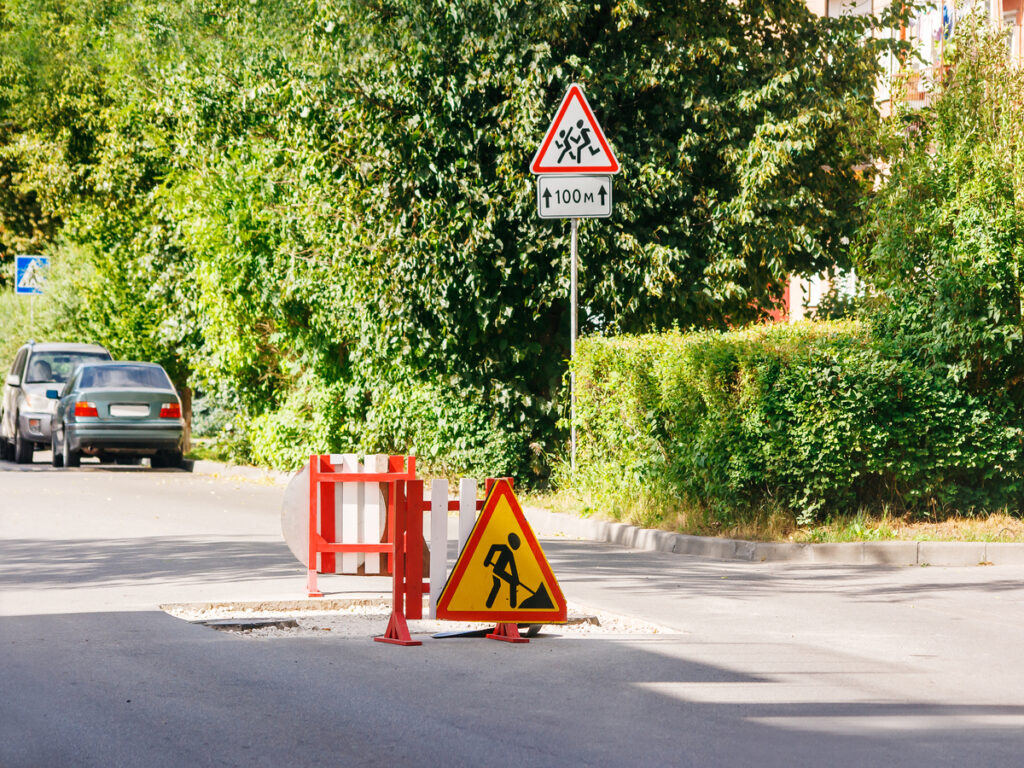
Mehr Sicherheit für Fahrer und Arbeiter
MUTCD-konforme Verkehrszeichenrahmen machen Straßen für alle sicherer. Diese Rahmen erfüllen die Höhenvorschriften, Stabilität, und Reflexionsvermögen. Reflektierende Materialien, Wie Diamantenblatt, Helfen Sie den Fahrern, nachts Schilder zu erkennen. Sie reflektieren Auto -Scheinwerfer, Verringerung von Unfallrisiken. Tagsüber, Helle Farben sorgen dafür, dass Schilder auch aus weiter Entfernung gut zu erkennen sind. Dies ist in Baustellen sehr hilfreich. Klare Schilder schützen die Arbeiter und leiten die Fahrer sicher durch diese Bereiche.
Notiz: Reflektierende Schilder helfen älteren Fahrern, die bei schlechten Lichtverhältnissen Probleme haben. Klare Schilder erleichtern auch die Navigation an Kreuzungen und Ausfahrten, Verbesserung des Verkehrsflusses.
| Besonderheit | Beschreibung |
|---|---|
| ASTM D4956-Konformität | Erfüllt die Standards für reflektierende Folien Typ III und Typ IV. |
| Haltbarkeit | Die starke Beschichtung widersteht Kratzern und Beschädigungen. |
| Sichtbarkeit tagsüber | Helle Farben lassen Schilder bei Tageslicht hervorstechen. |
| Nachtsichtbarkeit | Spezielle Materialien verbessern die Sicht unter Scheinwerfern. |
| Umweltauswirkungen | Reflektierende Materialien sind umweltfreundlich hergestellt. |
Durch die Einhaltung der MUTCD-Regeln werden die Straßen für alle sicherer.
Rechtsschutz und weniger Risiken
Die Verwendung von MUTCD-kompatiblen Frames hilft, rechtliche Probleme zu vermeiden. Gerichte betrachten die Einhaltung der MUTCD als Beweis für gute Sicherheitspraktiken. Zum Beispiel, in Kalifornien, Richtige Verkehrseinrichtungen verringern rechtliche Risiken. In Washington, Die meisten Klagen wegen schlechter Vorzeichen werden frühzeitig beigelegt, häufig aufgrund fehlender MUTCD-Verstöße.
| Zustand | Rechtliche Auswirkungen |
|---|---|
| Kalifornien | Richtige Verkehrseinrichtungen reduzieren rechtliche Risiken. |
| Washington | Die meisten Fälle werden aufgrund fehlender MUTCD-Verstöße vorzeitig beigelegt. |
| Texas | Nur wenige Klagen betreffen MUTCD-Themen, Aber Fälle von Auftragnehmern kommen vor. |
| Alabama | Bessere Kurvenwarnungen verringern rechtliche Risiken. |
Die Verwendung von MUTCD-konformen Rahmen zeigt, dass Ihnen Sicherheit am Herzen liegt und reduziert rechtliche Probleme.
Schnellere Projekte und einfachere Genehmigungen
MUTCD-konforme Schilderrahmen Machen Sie Projekte schneller und einfacher zu genehmigen. Behörden bevorzugen Projekte, die den MUTCD-Regeln folgen, da sie eine sichere Verkehrskontrolle gewährleisten. Reflektierende Materialien helfen, indem sie sichtbar bleiben und länger halten. Projekte mit konformen Tools vermeiden Verzögerungen durch Ablehnungen.
Tipp: Verwenden Sie vorab zugelassene Rahmen mit zertifizierten reflektierenden Materialien, um alle Regeln von Anfang an zu erfüllen.
Die MUTCD-Konformität bedeutet auch, dass weniger Ersatz oder Reparaturen erforderlich sind. Strapazierfähige Materialien halten schlechtem Wetter und starker Beanspruchung stand, Zeit und Geld sparen. Zuverlässige Ausrüstung verbessert die Sicherheit und senkt die Projektkosten.
Durch Befolgen von MUTCD -Regeln, Sie können Projekte schneller abschließen und Genehmigungen einfacher erhalten. Dies gewährleistet eine sicherere und reibungslosere Verkehrssteuerung.
Mit der richtigen Ausrüstung im Laufe der Zeit Geld sparen
Kauf MUTCD-Mit konformen Verkehrszeichenrahmen können Sie langfristig Geld sparen. Diese Rahmen sind auf Langlebigkeit ausgelegt, Sie müssen sie also nicht oft reparieren oder ersetzen. Stark pflücken, Hochwertige Rahmen vermeiden zusätzliche Kosten durch schwache oder schlecht gefertigte Rahmen.
Warum MUTCD-kompatible Rahmen weniger kosten
- Starke Materialien: Diese Rahmen sind robust und halten schlechtem Wetter gut stand. Sie rosten nicht, biegen, oder leicht verblassen, hält länger als billigere Optionen.
- Weniger Wartung: Reflektierende Panels bleiben jahrelang hell. Sie müssen sie nicht oft ersetzen, Das spart sowohl Zeit als auch Geld.
- Weniger Ersatz: MUTCD-konforme Rahmen bleiben bei Wind und starkem Verkehr stabil. Dadurch wird verhindert, dass sie brechen, Sie müssen also nicht oft neue kaufen.
Tipp: Wenn Sie jetzt mehr für MUTCD-kompatible Rahmen ausgeben, sparen Sie später Geld. Robuste Rahmen halten länger und müssen weniger repariert werden, damit sie ihren Preis wert sind.
Kosten vergleichen: Konform vs. Nicht konforme Rahmen
| Besonderheit | MUTCD-kompatible Rahmen | Nicht konforme Rahmen |
|---|---|---|
| Haltbarkeit | Gebaut für die Ewigkeit | Geht schnell kaputt |
| Reflektierende Bleche | Bleibt jahrelang hell | Verblasst schnell |
| Instandhaltungskosten | Geringer Wartungsaufwand | Muss häufig repariert werden |
| Ersatzfrequenz | Selten ersetzt | Oft ersetzt |
Die Verwendung konformer Rahmen bedeutet, dass im Laufe der Zeit weniger Kosten für Reparaturen und Austausch anfallen. Nicht konforme Rahmen scheinen auf den ersten Blick günstiger zu sein, aber sie brechen häufiger, kostet am Ende mehr.
Langfristige Vorteile für Projekte
MUTCD-kompatible Rahmen sorgen für einen reibungsloseren Ablauf von Projekten. Stabile Rahmen verhindern Verzögerungen durch kaputte oder fehlende Schilder. Sie vermeiden auch Bußgelder bei Nichtbeachtung von Regeln, was überraschende Kosten verursachen kann.
Die Wahl konformer Rahmen schont Ihr Budget und sorgt für einen reibungslosen Ablauf. Das spart Geld und sorgt gleichzeitig für sichere Straßen und die Einhaltung gesetzlicher Standards.
Best Practices für die Einhaltung der MUTCD-Regeln
Wählen Sie Rahmen aus, die bereits zertifiziert sind
Es ist sinnvoll, bereits getestete und zertifizierte Rahmen zu verwenden. Diese Rahmen erfüllen die MUTCD-Regeln für die Höhe, Stabilität, und Sichtbarkeit. Sie werden getestet, um sicherzustellen, dass sie in realen Situationen gut funktionieren. Die Wahl zertifizierter Rahmen verringert das Risiko von Regelverstößen und macht die Straßen für alle sicherer.
Überall die gleichen Verkehrsgeräte zu haben, trägt dazu bei, die Straßen sicher zu halten. Die Federal Highway Administration (Fhwa) sagt, dass der Einsatz bewährter Sicherheitswerkzeuge Leben retten kann. Zertifizierte tragbare Schilderständer entsprechen diesen Sicherheitszielen. Sie funktionieren gut in verschiedenen Verkehrssituationen und sorgen für Konsistenz.
Überprüfen Sie die Höhe und Stabilität des Schildes vor Ort
Damit die Schilder gut sichtbar sind, müssen sie die richtige Höhe haben. Zum Beispiel, in Wandergebieten, Zeichen sollten sein 7 Füße hoch. Dadurch sind sie den Fußgängern nicht im Weg. Stabilität ist ebenfalls wichtig. Wackelige Schilder können herunterfallen und Probleme verursachen.
Verwenden Sie Werkzeuge wie Maßbänder, um die Schildhöhe zu überprüfen. Gewichte hinzufügen, Wie Sandsäure, um die Schilder bei windigem Wetter stabil zu halten. Durch regelmäßige Kontrollen wird sichergestellt, dass die Schilder aufrecht stehen und gut sichtbar sind, Auch unter schwierigen Bedingungen.
Überprüfen Sie die Schilder während des Gebrauchs häufig
Die Überprüfung von Schildern hilft oft dabei, Probleme wie verblasste Schilder oder schiefe Schilder zu beheben. Manche Leute streiten darüber, ob die Inspektion tagsüber oder nachts erfolgen soll. Nachtkontrollen zeigen, wie sichtbar Zeichen im Dunkeln sind. Tageskontrollen helfen, Schäden oder Graffiti zu erkennen. Beide Arten von Kontrollen sind sinnvoll.
Dinge wie der Anbau von Pflanzen, Schlechtes Wetter, oder Vandalismus kann Schilder mit der Zeit blockieren. Regelmäßige Inspektionen helfen Ihnen, diese Probleme schnell zu beheben. Dadurch wird sichergestellt, dass die Schilder gut funktionieren und den Regeln entsprechen. Durch häufiges Überprüfen der Schilder, Sie machen die Straßen sicherer und vermeiden Verstöße gegen die MUTCD-Regeln.
Informieren Sie Ihr Team über die MUTCD-Regeln
Bringen Sie Ihrem Team bei MUTCD Regeln tragen dazu bei, die Straßen sicher zu halten. Es stellt außerdem sicher, dass sie wissen, wie Verkehrszeichenrahmen richtig eingerichtet und verwaltet werden. Das verringert Fehler und macht Verkehrszonen sicherer.
Warum Unterricht wichtig ist
Ohne Ausbildung, Arbeiter könnten den Schlüssel verpassen MUTCD Regeln. Zum Beispiel, Sie könnten Schilder zu niedrig platzieren oder Materialien verwenden, die kein Licht reflektieren. Diese Fehler können zu Unfällen führen, rechtliche Probleme, oder Projekte verlangsamen. Schulungen helfen Ihrem Team dabei, die richtige Platzierung zu erlernen, sicher, und Zeichen sichtbar machen.
Tipp: Halten Sie regelmäßig Unterricht ab, um Ihr Team auf dem Laufenden zu halten MUTCD Änderungen.
Was man in der Ausbildung lehren sollte
Konzentrieren Sie sich im Training auf diese wichtigen Themen:
- Schildplatzierung: Zeigen Sie, wie Sie Schilder basierend auf Geschwindigkeit und Gehbereichen platzieren.
- Reflektierende Materialien: Erklären Sie, warum die Verwendung reflektierender Materialien für die Sichtbarkeit wichtig ist.
- Schilder stabil halten: Bringen Sie bei, wie Sie mit Gewichten oder Ankern verhindern, dass Schilder herunterfallen.
- Schilder prüfen: Schulen Sie Ihre Mitarbeiter darin, Probleme wie verblasste Schilder oder schiefe Rahmen zu erkennen und zu beheben.
So trainieren Sie effektiv
Nutzen Sie verschiedene Methoden, um Ihr Team zu unterrichten:
- Übungsstunden: Lassen Sie die Mitarbeiter in einem sicheren Bereich Schilder aufstellen und überprüfen.
- Visuelle Werkzeuge: Nutzen Sie Bilder und Videos zur Erklärung MUTCD Regeln.
- Quiz: Testen Sie ihr Wissen mit einfachen Fragen.
- Schulung vor Ort: Üben Sie in realen Verkehrszonen, um echte Probleme zu lösen.
Notiz: Führen Sie Aufzeichnungen über alle Schulungssitzungen, um den Fortschritt zu verfolgen und sicherzustellen, dass alle lernen.
Indem Sie Ihr Team gut unterrichten, Sie schaffen sicherere Straßen und folgen ihnen MUTCD Regeln. Ein geschultes Team macht weniger Fehler und meistert die Verkehrskontrolle besser.
Tipps zum Erwerb MUTCD-kompatibler Geräte
Fordern Sie einen Nachweis der MUTCD-Konformität an
Beim Kauf von Verkehrsschildrahmen, Bitten Sie die Anbieter um einen Nachweis, dass sie die MUTCD-Regeln einhalten. Dadurch wird sichergestellt, dass die Ausrüstung sicher ist und ordnungsgemäß funktioniert. Anbieter sollten einen klaren Nachweis erbringen, dass ihre Produkte den MUTCD-Standards für die Höhe entsprechen, Stabilität, und Reflexionsvermögen.
Jeder Fall sollte vom Grundstückseigentümer oder seinen Ingenieuren geprüft werden. Sie müssen entscheiden, ob die MUTCD-Regeln gelten, und ihre Begründung dokumentieren. Diese Aufzeichnung kann hilfreich sein, wenn es in Zukunft zu Streitigkeiten über die Verwendung von MUTCD kommt.
Der Erhalt dieses Nachweises schützt Ihr Projekt vor rechtlichen Problemen. Es zeigt auch, dass Ihnen Sicherheit und die Einhaltung der Regeln am Herzen liegen.
Verwenden Sie eine Checkliste, um die Einhaltung zu überprüfen
Eine Checkliste erleichtert den Kauf von MUTCD-konformer Ausrüstung. Schreiben Sie die MUTCD-Regeln auf, wie Schildhöhe, Reflexionsvermögen, und Rahmenstabilität. Nutzen Sie diese Liste, um Anbieter und deren Produkte zu überprüfen. Hier entlang, Sie wählen nur Ausrüstung aus, die den Regeln entspricht.
Zum Beispiel, Ihre Checkliste könnte fragen:
- Entspricht der Rahmen den Höhenregeln für Geh- und Fahrbereiche??
- Sind die reflektierenden Materialien für die Sichtbarkeit bei schlechten Lichtverhältnissen zertifiziert??
- Ist der Rahmen stark genug, um Wind und Wetter standzuhalten??
Eine Checkliste sorgt für Ordnung und stellt sicher, dass Sie nichts Wichtiges verpassen.
Fügen Sie MUTCD-Regeln zu Ausschreibungen und Verträgen hinzu
Beziehen Sie MUTCD-Regeln in Ihre ein Angebotsanfragen (Ausschreibungen) und Verträge. Dadurch erfahren Anbieter sofort, was Sie erwarten. Es stellt außerdem sicher, dass die Ausrüstung den Sicherheits- und Leistungsstandards entspricht.
- Das Hinzufügen von MUTCD-Regeln verbessert die Sicherheit und Effizienz bei der Bewältigung von Verkehrsunfällen.
- Schulungsprogramme für Einsatzkräfte betonen die Notwendigkeit, die MUTCD-Regeln einzuhalten.
- Neue Transporttechnologien müssen den MUTCD-Standards entsprechen, um Einsatzkräfte zu unterstützen und Vorfälle besser zu bewältigen.
Indem wir diese Regeln klar formulieren, Sie vermeiden den Kauf von Geräten, die nicht den Anforderungen entsprechen. Das spart Zeit und verhindert kostspielige Verzögerungen.
Arbeiten Sie mit vertrauenswürdigen Anbietern für Verkehrssicherheitsausrüstung zusammen
Die Auswahl des richtigen Anbieters ist der Schlüssel zu sichereren Straßen. Vertrauenswürdige Anbieter wie OPTRAFFIC Verkaufen Sie getestete Produkte, die den MUTCD-Regeln entsprechen. Sie bieten auch intelligente Tools zur Verkehrssteuerung und Unfallverhütung.
Gute Anbieter konzentrieren sich darauf, Verkehrsprobleme mit Spezialwerkzeugen zu lösen. Zum Beispiel, Radar-Geschwindigkeitsanzeigen helfen Fahrern, ihre Geschwindigkeit zu erkennen und sicherer zu fahren. Blinkende LED-Stoppschilder verhindern Unfälle 41.5%, sagt das Verkehrsministerium von Minnesota. Diese Schilder erregen Aufmerksamkeit und erhöhen die Sicherheit an Kreuzungen.
Erfahrene Anbieter nutzen oft fortschrittliche Technologie. Das Wrong-Way-Prevention-System von TraffiCalm verhindert, dass Autos falsch fahren. Dieses System nutzt intelligente Konstruktionen, um Unfälle zu verhindern. Stoppschild-Leuchten verringern die Zahl der nächtlichen Unfälle 54%. Durch ihre hellen Lichter sind Schilder auch im Dunkeln gut zu erkennen.
Die Zusammenarbeit mit Anbietern, die die MUTCD-Regeln kennen, stellt sicher, dass Sie legale Ausrüstung erhalten. Diese Anbieter helfen auch bei der Einrichtung und Pflege, So vermeiden Sie Fehler. Ihre Produkte halten lange und trotzen schlechtem Wetter, Geldsparen für Ersatz sparen.
Wählen Sie Anbieter mit langjähriger Erfahrung in der Verkehrssicherheit. Suchen Sie nach Unternehmen, die neue, forschungsgestützte Ideen anbieten. Durch die Zusammenarbeit mit vertrauenswürdigen Anbietern, Sie können die Straßen sicherer machen und die MUTCD-Regeln befolgen.
Die MUTCD-Regeln tragen dazu bei, die Straßen sicherer und den Verkehrsfluss zu verbessern. Sie umfassen zwei Arten von Sicherheit: Designsicherheit und reale Sicherheit.
| Konzept | Bedeutung |
|---|---|
| Designsicherheit | Befolgen Sie grundlegende Designregeln aus nationalen oder staatlichen Leitfäden. |
| Sicherheit im wirklichen Leben | Wie gut Sicherheit funktioniert, wie die Reduzierung von Unfällen und Verletzungen. |
Verwendung zugelassener Werkzeuge, Überprüfung der Setups, und die Auswahl guter Anbieter kann Fehler verhindern. Diese intelligente Planung sorgt für sichere Straßen und beschleunigt Projektgenehmigungen.
FAQ
1. Was bedeutet MUTCD-Konformität für tragbare Verkehrszeichenrahmen??
MUTCD-Konformität bedeutet, dass die Schilderrahmen den nationalen Sicherheitsvorschriften entsprechen. Diese Regeln beziehen sich auf die Körpergröße, Stabilität, Reflexionsvermögen, und Lesbarkeit. Wenn Sie sie befolgen, werden die Straßen sicherer, vermeidet rechtliche Probleme, und sorgt für einen reibungslosen Verkehr in den Arbeitsbereichen.
2. Wie können Sie überprüfen, ob ein Verkehrszeichenrahmen MUTCD-konform ist??
Bitten Sie den Verkäufer um einen Nachweis, dass der Rahmen den Regeln entspricht. Verwenden Sie eine Checkliste, um Dinge wie die Körpergröße zu bestätigen, Reflexionsvermögen, und Stabilität. Sie können den Rahmen auch vor Ort überprüfen, um sicherzustellen, dass er den MUTCD-Standards entspricht.
3. Warum ist reflektierendes Material für Verkehrsschilder wichtig??
Reflektierende Materialien erleichtern die Sichtbarkeit von Schildern bei Nacht oder schlechtem Wetter. Sie werden von Autoscheinwerfern reflektiert, hilft Autofahrern, Schilder schon aus der Ferne zu erkennen. MUTCD legt die Helligkeitsstufen fest, um die Straßen für alle sicher zu machen.
4. Was passiert, wenn Sie nicht konforme Verkehrszeichenrahmen verwenden??
Die Verwendung nicht konformer Rahmen kann zu Sicherheitsproblemen führen, rechtliche Fragen, und Verzögerungen. Schilder, die den Regeln nicht entsprechen, sind möglicherweise schwer zu erkennen, umfallen, oder falsch platziert werden, Unfälle und Geldstrafen sind die Folge.
5. Wie oft sollten Sie die Rahmen von Verkehrsschildern vor Ort überprüfen??
Kontrollieren Sie die Verkehrszeichenrahmen bei längerem Gebrauch täglich. Stellen Sie sicher, dass sie die richtige Höhe haben, stabil, und leicht zu sehen. Suchen Sie nach Problemen wie verblassten Panels, schiefe Schilder, oder Schäden durch Wetter oder Vandalismus. Regelmäßige Kontrollen sorgen dafür, dass die Straßen sicher und ordnungsgemäß sind.

